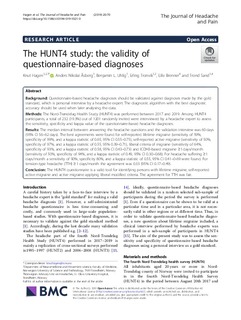| dc.contributor.author | Hagen, Knut | |
| dc.contributor.author | Åsberg, Anders Nikolai | |
| dc.contributor.author | Uhlig, Benjamin Langsæter | |
| dc.contributor.author | Tronvik, Erling Andreas | |
| dc.contributor.author | Brenner, Eiliv | |
| dc.contributor.author | Sand, Trond | |
| dc.date.accessioned | 2019-07-01T10:45:39Z | |
| dc.date.available | 2019-07-01T10:45:39Z | |
| dc.date.created | 2019-06-28T08:08:27Z | |
| dc.date.issued | 2019 | |
| dc.identifier.issn | 1129-2369 | |
| dc.identifier.uri | http://hdl.handle.net/11250/2602994 | |
| dc.description.abstract | Background
Questionnaire-based headache diagnoses should be validated against diagnoses made by the gold standard, which is personal interview by a headache expert. The diagnostic algorithm with the best diagnostic accuracy should be used when later analysing the data.
Methods
The Nord-Trøndelag Health Study (HUNT4) was performed between 2017 and 2019. Among HUNT4 participants, a total of 232 (19.3%) out of 1201 randomly invited were interviewed by a headache expert to assess the sensitivity, specificity and kappa value of the questionnaire-based headache diagnoses.
Results
The median interval between answering the headache questions and the validation interview was 60 days (95% CI 56–62 days). The best agreements were found for self-reported lifetime migraine (sensitivity of 59%, specificity of 99%, and a kappa statistic of 0.65, 95% CI 0.55–0.75), self-reported active migraine (sensitivity of 50%, specificity of 97%, and a kappa statistic of 0.55, 95% 0.39–0.71), liberal criteria of migraine (sensitivity of 64%, specificity of 93%, and a kappa statistic of 0.58, 95% CI 0.43–0.73) and ICDH3-based migraine ≥1 days/month (sensitivity of 50%, specificity of 94%, and a kappa statistic of 0.49, 95% CI 0.30–0.68). For headache suffering ≥1 days/month a sensitivity of 90%, specificity 80%, and a kappa statistic of 0.55, 95% CI 0.41–0-69 were found. For tension-type headache (TTH) ≥ 1 days/month the agreement was 0.33 (95% CI 0.17–0.49).
Conclusion
The HUNT4 questionnaire is a valid tool for identifying persons with lifetime migraine, self-reported active migraine and active migraine applying liberal modified criteria. The agreement for TTH was fair. | nb_NO |
| dc.language.iso | eng | nb_NO |
| dc.rights | Attribution-NonCommercial-NoDerivatives 4.0 Internasjonal | * |
| dc.rights | Navngivelse 4.0 Internasjonal | * |
| dc.rights.uri | http://creativecommons.org/licenses/by/4.0/deed.no | * |
| dc.title | The HUNT4 study: the validity of questionnaire-based diagnoses | nb_NO |
| dc.type | Journal article | nb_NO |
| dc.type | Peer reviewed | nb_NO |
| dc.description.version | publishedVersion | nb_NO |
| dc.source.volume | 20 | nb_NO |
| dc.source.journal | The Journal of Headache and Pain | nb_NO |
| dc.source.issue | 70 | nb_NO |
| dc.identifier.doi | 10.1186/s10194-019-1021-0 | |
| dc.identifier.cristin | 1708487 | |
| dc.description.localcode | © The Author(s). 2019 Open Access This article is distributed under the terms of the Creative Commons Attribution 4.0 International License (http://creativecommons.org/licenses/by/4.0/) | nb_NO |
| cristin.unitcode | 1920,0,0,0 | |
| cristin.unitcode | 194,65,30,0 | |
| cristin.unitname | St. Olavs Hospital HF | |
| cristin.unitname | Institutt for nevromedisin og bevegelsesvitenskap | |
| cristin.ispublished | true | |
| cristin.fulltext | original | |
| cristin.qualitycode | 1 | |

